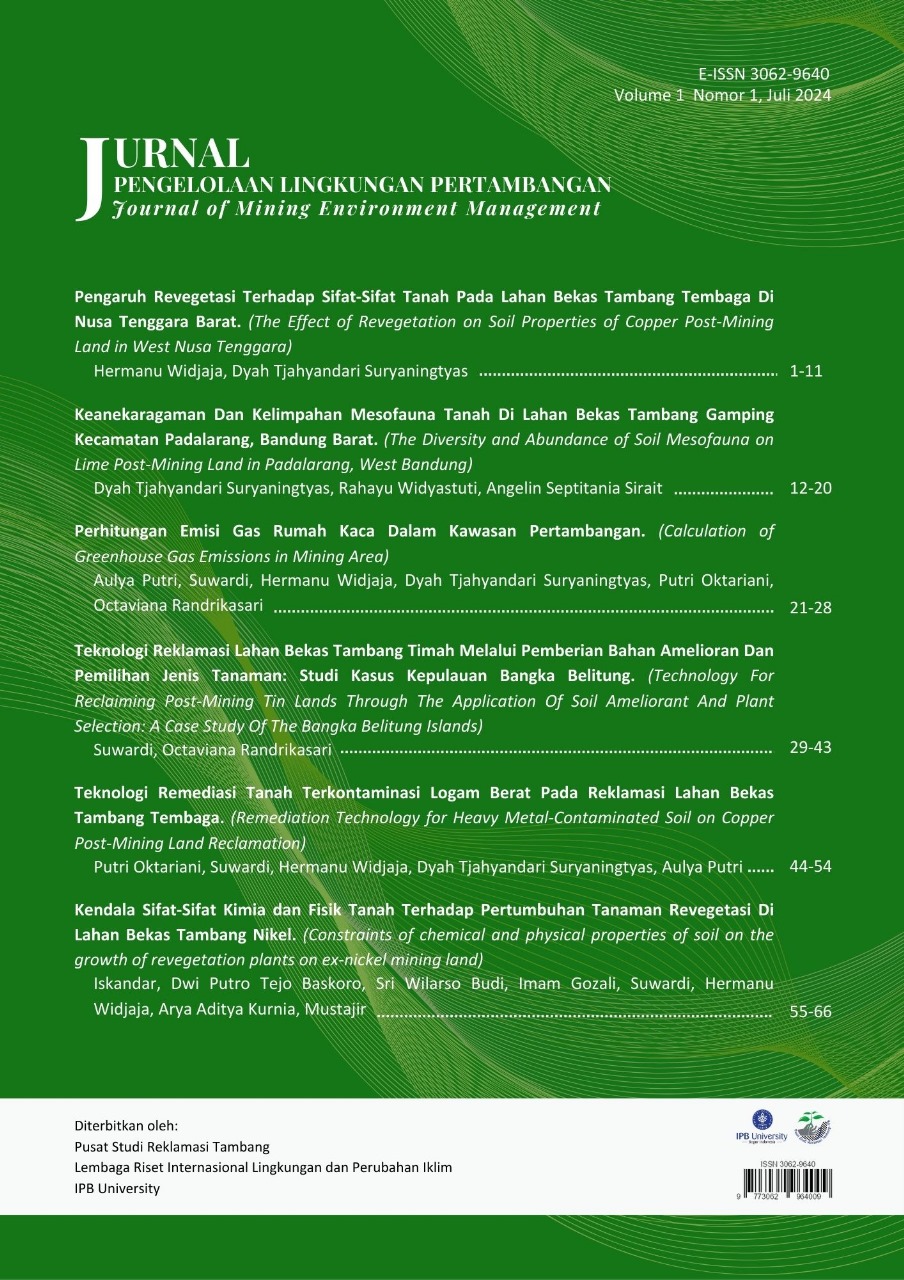The Effect of Revegetation on Soil Properties of Copper Post-Mining Land in West Nusa Tenggara
Abstract
Copper mining activities mainly using open-pit techniques, lead to environmental issues such as overburden waste in waste dump areas that have potential to generate acid mine drainage (AMD), which can decrease soil pH and increase heavy metal toxicity. Reclamation efforts, including revegetation using pioneer plants and cover crops are necessary to restore degraded land in waste dump areas. The aim of this research is to analyze soil physical and chemical properties improvement after revegetation on copper post-mining land as an evaluation and to provide recommendations for future reclamation. The research was carried out by analyzing and interpreting laboratory data from soil observations in revegetation areas for the 2016, 2018, 2019 and 2020 planting years, as well as natural forests belonging to PT. Amman Mineral Nusa Tenggara. Revegetation of copper post-mining land does not show a significant improvement in soil physical properties because improving physical properties takes quite a long time, especially in post-mining areas with heavy structural damage. Soil chemical properties analysis shows that revegetation can increase base saturation (BS), cation exchange capacity (CEC), exch-Ca, exch-Mg, and reduce soil Al saturation. In contrast, soil pH, organic-C, total-N, and soil available-P in the revegetation area did not increase as the revegetation age increased. The effect of revegetation appears to be more significant at the age of 2 to 3 years. However, based on the Tukey test, the age of revegetation mostly does not have a significant effect on enhancing soil chemical properties.
References
Aanisa, N. A. I., Rahmawati, R., Tasiman, B. H. A., & Astuti, Y. (2023). Analisis Kualitas dan Tingkat Pencemaran Limbah B3 Terlarut di Aliran Sungai Cideng. Jurnal Ilmu Lingkungan, 22(1), 215–227.
Arsyad, S. (2010). Konservasi Tanah & Air. IPB Press. http://repository.ipb.ac.id/handle/123456789/42667.
Balai Pengujian Standar Instrumen Tanah dan Pupuk. (2023). Petunjuk Teknis: Analisis Kimia Tanah, Tanaman, Air, dan Pupuk (3rd ed.). Balai Penelitian Tanah.
Bintoro, A., Widjajanto, D., & Isrun, I. (2017). Karakteristik Fisik Tanah Pada Beberapa Penggunaan Lahan Di Desa Beka Kecamatan Marawola Kabupaten Sigi. AGROTEKBIS : JURNAL ILMU PERTANIAN (e-Journal), 5(4), Article 4.
Iskandar, & Suwardi. (2009, 22 Oktober). Meningkatkan Keberhasilan Reklamasi Lahan Bekas Tambang. Seminar Nasional Pengelolaan Lingkungan Pertambangan, Lembaga Penelitian Universitas Sriwijaya. http://repository.ipb.ac.id/handle/123456789/62634.
Jama, N. A., Monde, A., & A.rajamuddin, U. (2016). Karakteristik Fisik Tanah Daerah Aliran Sungai (DAS) Wuno Bagian Hulukabupaten Sigi. Agrotekbis, 4(3), 248333. https://www.neliti.com/publications/248333/.
Lestari, K. G., Budi, S. W., & Suryaningtyas, D. T. (2022). The impact of revegetation activities in various post-mining lands in Indonesia (study of literature). IOP Conference Series: Earth and Environmental Science, 959(1), 012038. https://doi.org/10.1088/1755-1315/959/1/012038.
[LPT] Lembaga Penelitian Tanah. (1979). Penuntun Analisa Fisika Tanah. Lembaga Penelitian Tanah. Badan Litbang Pertanian. Balai Penelitian Tanah.
Paz Ferreiro, J., Pereira De Almeida, V., Cristina Alves, M., Aparecida De Abreu, C., Vieira, S. R., & Vidal Vázquez, E. (2016). Spatial Variability of Soil Organic Matter and Cation Exchange Capacity in an Oxisol under Different Land Uses. Communications in Soil Science and Plant Analysis, 47(sup1), 75–89. https://doi.org/10.1080/00103624.2016.1232099.
Pranata, Z. S. (2023). Keterkaitan Revegetasi dengan Karakteristik Sifat Tanah pada Lahan Pascatambang Tembaga di Nusa Tenggara Barat. Bogor: Institut Pertanian Bogor. http://repository.ipb.ac.id/handle/123456789/122554.
Putri, A., Iskandar, I., Oktariani, P., & Limin, A. (2023). Effect of Coal Ash Enriched Compost on Soil Chemical Properties of Ultisols. IOP Conference Series: Earth and Environmental Science, 1266(1), 012076. https://doi.org/10.1088/1755-1315/1266/1/012076.
Rachman, L. M., Baskoro, D. P. T., Wahjunie, E. D., Nurmilah, A., Astriani, T., & Dewi, N. M. (2019). Evaluasi Sifat Fisik Tanah Pengendali Kemampuan Tanah Memegang Air dan Memasok Air Bagi Tanaman serta Kaitannya Dengan Manajemen Pertanian pada Lahan Sub Optimal. Seminar Nasional Lahan Suboptimal, 1, Article 1.
Sembiring, I. S., Wawan, & Khoiri, M. A. (2016). Sifat kimia tanah dystrudepts dan pertumbuhan akar tanaman kelapa sawit (Elaeis guineensis Jacq.) yang diaplikasi mulsa organik Mucuna bracteata. Jurnal Online Mahasiswa (JOM) Bidang Pertanian, 2(2), 1-11.
Sofyan, R. H., Wahjunie, E. D., & Hidayat, Y. (2017). Karakterisasi Fisik Dan Kelembaban Tanah Pada Berbagai Umur Reklamasi Lahan Bekas Tambang. Buletin Tanah Dan Lahan, 1(1), Article 1.
Wilson, W., Supriadi, S., & Guchi, H. (2015). Evaluasi Sifat Kimia Tanah Pada Lahan Kopi Di Kabupaten Mandailing Natal. Jurnal Agroekoteknologi Universitas Sumatera Utara, 3(2), 104299. https://doi.org/10.32734/jaet.v3i2.10345.
Copyright (c) 2024 Hermanu Widjaja, Dyah Tjahyandari Suryaningtyas

This work is licensed under a Creative Commons Attribution-NonCommercial-ShareAlike 4.0 International License.













